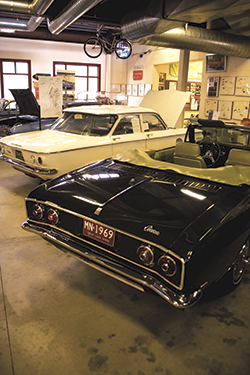
Detroit has more car shows than Hollywood has star-lets. After a while, even the most ardent fan of Corvettes or vintage Mustangs or Dodge Super Bees can grow jaded. Ho-hum, another cherry ’57 Chevy. What’s for lunch?
That’s where Jack Miller has an ace up his sleeve. No Corvettes allowed at the Orphan Car Show, which he co-founded and co-chairs. Held the first Sunday in June in Ypsilanti, the show spotlights only makes that have been out of production or not imported to the United States for at least seven years. There are a few exceptions made for sentimental reasons. Although Chevrolet is still alive and well, Corvairs are admitted because of their history of local manufacture. But the plucky little rear-engine Chevy, doomed to an early death by Ralph Nader, also epitomizes the spirit of much of automotive orphanhood — a good idea with a tragic flaw, perhaps ahead of its time, loved too well by too few.
At least, that’s the idea you get from talking to Miller, who curates Ypsilanti’s Automotive Heritage Museum, housed in his late father’s former Hudson dealership, a building that’s stayed in the family even though Hudson went out of business half a century ago. He’s a fierce Hudson partisan. Ken Poynter, mayor of Harper Woods, is even fiercer: The Hudson brand was a victim of its own success, he believes.
“They were so well-built, they didn’t wear out,” he states flatly. “If you had a Hudson on the road today, it could keep up with any modern car, speed-wise, and you’d feel safe in it.”
This is the mindset of many an orphan-car fan, stubbornly keeping the embers aglow long after the fire has died out. Others are in it for the oddities — the foreign-car division in the summer show always draws a Trabant or two, a relic of the former East Germany, dismissed by Time magazine as one of the 50 worst cars of all time, “powered by a two-stroke pollution generator that maxed out at an ear-splitting 18 horsepower, the Trabant was a hollow lie of a car constructed of recycled worthlessness.” (Miller dismisses it more succinctly, as an “upholstered wheelbarrow.”)
There are beauties from the early days of the automobile, stretching on past World War II — Auburn, Cord, Graham-Paige, Hupmobile, Kaiser, Frazer. There are Austin-Healys, Sprites, Triumphs, Nash, Ramblers, even Fiat-Jollys (an automotive surrey with the fringe on top). This year, the show will welcome its first Plymouths, out of production in 2001. Oldsmobiles will become eligible in 2011.
The highlight of the show is the pass-in-review, narrated by a number of automotive historians, who point out the quirks and triumphs of each entrant. It’s a quick course in not only industrial America’s accomplishments, but legendary misfires, too, Miller says, ticking off some examples: Preston Tucker’s famous three-headlight design was ahead of its time, but its founder was heedless as a businessman. Hudson, like many smaller companies after World War II, had to merge with other brands to stay competitive (Hudson and Nash became American Motors), lost its distinctiveness, and perished. And as for the daring, doomed DeLorean, well, everybody knows that story.
Miller says if there’s one comment you hear over and over at the Orphan Car Show, it’s “That was my first car!” Many of these odd ducks were working their way down the secondhand market when today’s car-show enthusiasts were getting their licenses, and everyone remembers their first wheels with at least some fondness.
In the case of Mayor Poynter, it’s a family tradition. His dad raised a family on a Hudson worker’s wages, and Poynter hasn’t forgotten. His collection of Hudson memorabilia, which he confidently calls the largest in the world, will go on loan to the Automotive Heritage Museum soon. With items ranging from dealer giveaways, to styling studio car models, to war-era security-clearance badges for the factory floor, he sees it as a bulwark against the march of history, and the inevitable forgetting of what he thinks was an outstanding car.
“Hudson dominated Nascar in its early years,” he points out. (Indeed, the success of Pixar’s Cars, with Paul Newman playing crusty old ex-racer Doc Hudson, has revived interest in the company.) His 1942 Commodore 6 convertible is all pudgy curves, reminiscent of a sunnier America, when it seemed the whole world rolled on whitewall tires and chrome. “For quality and safety, you couldn’t beat it,” Poynter says.
For Miller, whose family business shifted from selling new Hudsons to used ones only a year later, that’s exactly the appeal, too. Automotive orphanhood need not carry a taint, not if there are still a few willing to keep the last ones running. Ralph Nader is 73, but chances are some drivers will still treasure their Corvairs long after he’s gone.
|
|
|









